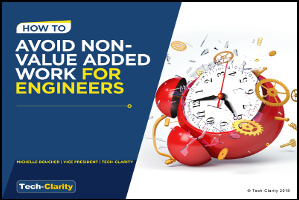 How can a company better utilize engineers’ time?
How can a company better utilize engineers’ time?
Today’s market is hyper competitive; it is hard to stand out. To be successful, companies must empower their engineering teams to focus on product innovation, quality, performance and cost. Balancing those key criteria is challenging enough, but made even more challenging as engineers report they waste a third of their time on non-value added work. Tech-Clarity’s How-To Guide: Avoid Non-Value Added Work For Engineers explores how to overcome this challenge. Based on a survey of nearly 250 manufacturers, the report reveals best practices for managing data, communicating engineering changes, and collaborating with internal and external members of the development team. Together, these practices will help engineers focus more of their effort on making products more competitive.
Please enjoy the summary* below. For the full report, please visit our sponsor Dassault Systèmes (registration required).
TABLE OF CONTENTS
- Identify Bottlenecks
- Assess Non-Value Added Time
- Business Value of Eliminating Non-Value Added Work
- Recognize the Time Required for Check-ins
- Outdated Information Impacts Engineering Changes
- The Impact of Outdated Information on Collaboration
- Identifying the Top Performers
- Technology As a Collaboration Solution
- Consider the Security Risks of Email
- The Benefits of Real-Time Data Updates
- Recommendations
- About the Research
Executive Overview
Engineering Is Key to Competitive Differentiation
Today’s market is so competitive; it is hard to stand out. To be successful companies must empower their engineering teams to differentiate products on innovation, quality, performance, and cost. While balancing all those criteria can be a challenge, it is made even harder as engineers report they waste a third of their time on non-value added work. Even worse, 20 % of their time is spent working with outdated information, leading to more wasted effort and rework. One way companies can improve this situation is to provide engineers with real-time access to design data, in the right context. The result should be increased engineering bandwidth so engineers can focus more effort on making products more competitive.
% of their time is spent working with outdated information, leading to more wasted effort and rework. One way companies can improve this situation is to provide engineers with real-time access to design data, in the right context. The result should be increased engineering bandwidth so engineers can focus more effort on making products more competitive.
Determining Best Practices
To determine best practices for accessing design information, Tech-Clarity analyzed survey responses from nearly 250 manufacturers to understand how they manage data, communicate engineering changes, and collaborate with both internal and external members of the development team.
The research shows that companies who are most successful, Top Performers, are nearly 2-times more likely to maintain up-to-date models. PDM/PLM makes these real-time updates possible.
What Can You Learn from This Research?
 This report explores best practices for streamlining access to design data in real-time. It also exposes some challenges manufacturers should be aware of as they strive to maintain a competitive edge in today’s complex and cutthroat environment. The report also reveals how manufacturers can plan for a design environment that will prepare them for long-term competitiveness.
This report explores best practices for streamlining access to design data in real-time. It also exposes some challenges manufacturers should be aware of as they strive to maintain a competitive edge in today’s complex and cutthroat environment. The report also reveals how manufacturers can plan for a design environment that will prepare them for long-term competitiveness.
RECOMMENDATIONS
Next Steps
Based on industry experience and research for this report, Tech-Clarity offers the following recommendations:
- Understand how engineers spend their time and improve processes to minimize time wasted on non-value added work
- Consider solutions such as PLM or PDM to centralize design information and support change management and collaboration
- Evaluate options to design in the context of the assembly to improve collaboration and understand the impact of changes
- Consider real-time updates to keep CAD data up-to-date while minimizing or eliminating check-in times
- Establish means for secure, real-time collaboration with third parties to minimize delays in getting updated CAD data from them
*This summary is an abbreviated version of the eBook and does not contain the full content. A link to download the full eBook is available above.
If you have difficulty obtaining a copy of the research, please contact us.

